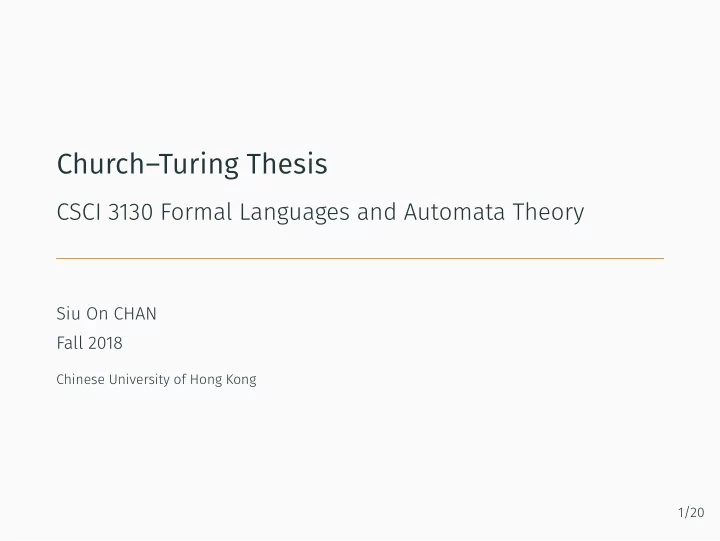

Church–Turing Thesis CSCI 3130 Formal Languages and Automata Theory Siu On CHAN Fall 2018 Chinese University of Hong Kong 1/20
What is a computer? computer program input output A computer is a machine that manipulates data according to a list of instructions 2/20
What is a computer? def hello(name): print("Hello ", name) world Hello world Google Now Will it rain today? No, rain is not expected today at Ma Liu Shui Machine Learning algorithm Environment self driving 3/20
Turing machines head Has two special states accept and reject Unlimited tape space blanks input state control 4/20 a … b a � � � �� � � �� � Can both read from and write to the tape Head can move both left and right
Example Strategy: Read and remember the fjrst symbol abbaa#abbaa Cross it off xbbaa#abbaa Read the fjrst symbol past # xbbaa#abbaa If they don’t match, reject If they do, cross it off xbbaa#xbbaa 5/20 L 1 = { w # w | w ∈ { a , b } ∗ }
Example Strategy: Look for and remember the fjrst uncrossed symbol xbbaa#xbbaa Cross it off xxbaa#xbbaa Read the fjrst symbol past # xxbaa#xbbaa If they do, cross it off, else reject xxbaa#xxbaa At the end, there should be only x ’s xxxxx#xxxxx if so, accept; otherwise reject 6/20 L 1 = { w # w | w ∈ { a , b } ∗ }
How Turing machines operate current state: q 1 … b b a a/bL q 2 q 1 new state: q 2 Replace a with b, and move head left … a b a a/bL q 2 q 1 7/20 � � � �
Computing devices: from practice to theory
Brief history of computing devices Antikythera Mechanism (~100BC) Its reproduction Abacus (Sumer 2700-2300BC, China 1200) Babbage Difference engine (1840s) Photo source: Wikipedia 8/20
Brief history of computing devices: programmable devices Z3 (Germany, 1941) ENIAC (Pennsylvania, US, 1945) Personal computers (since 1970s) Mobile phones Photo source: Wikipedia 9/20
Computation is universal Turing machine In principle, all computers have the same problem solving ability If an algorithm can be implemented on any realistic computer, then it can be implemented on a Turing machine 10/20
Church–Turing Thesis Turing machine DNA computing Quantum computing 11/20
Alan Turing Alan Turing aged 16 (1912-1954) Invented the Turing Test to tell apart humans from computers Broke German encryption machines during World War II Turing Award is the “Nobel prize of Computer Science” Turing’s motivation: Understand the limitations of human computation by studying his “automatic machines” 12/20
Hilbert’s Entscheidungsproblem, 1928 reformulation David Hilbert of primes of the form p and There are infjnitely many pairs Twin prime conjecture: has no integer solution Fermat’s last theorem: Examples of statements expressible in fjrst-order logic: but to “design a procedure” In fact, he didn’t ask to “write a program”, whether the statement is true Output: (in fjrst-order logic) mathematical statement Input: “Write a program” to solve the following task: Entscheidungsproblem (Decision Problem) 13/20 x n + y n = z n for integer n � 3 p + 2
Undecidability Entscheidungsproblem (Decision Problem) Design a procedure to solve the following task: Input: mathematical statement (in fjrst-order logic) Output: whether the statement is true Church (1935-1936) and Turing (1936-1937) independently showed the procedure that Entscheidungsproblem asks for cannot exist! 14/20 Defjnitions of procedure/algorithm: λ -calculus (Church) and automatic machine (Turing)
Church–Turing Thesis Church–Turing Thesis Intuitive notion of algorithms coincides with those implementable on Turing machines Supporting arguments: 1. Turing machine is intuitive 2. Many independent defjnitions of “algorithms” turn out to be equivalent References: Alan Turing, “On Computable Numbers, with an Application to the Entscheidungsproblem”, 1937 Alonzo Church, “A Note on the Entscheidungsproblem”, 1936 15/20
Formal defjnition of Turing machine Turing machines are deterministic 16/20 A Turing Machine is ( Q , Σ , Γ , δ, q 0 , q acc , q rej ) , where • Q is a fjnite set of states • Σ is the input alphabet, not containing the blank symbol � • Γ is the tape alphabet ( Σ ⊆ Γ ) including � • q 0 ∈ Q is the initial state • q acc , q rej ∈ Q are the accepting and rejecting states • δ is the transition function δ : ( Q \ { q acc , q rej } ) × Γ → Q × Γ × { L , R }
Confjgurations q 1 abb q acc … b b a q acc a / b R q acc 17/20 A confjguration consists of current state, head position, and tape … a b a q 1 (abbreviation) Confjguration contents � ab q 1 a �
Confjgurations one step Example: yields abb q acc 18/20 The start confjguration of the TM on input w is q 0 w We say a confjguration C yields C ′ if the TM can go from C to C ′ in ab q 1 a An accepting confjguration is one that contains q acc A rejecting confjguration is one that contains q rej
The language of a Turing machine A Turing machine M accepts x if there is a sequence of The language recognized by M is the set of all strings that M accepts 19/20 confjgurations C 0 , C 1 , . . . , C k where C i yields C i + 1 C 0 is starting C k is accepting
Recommend
More recommend